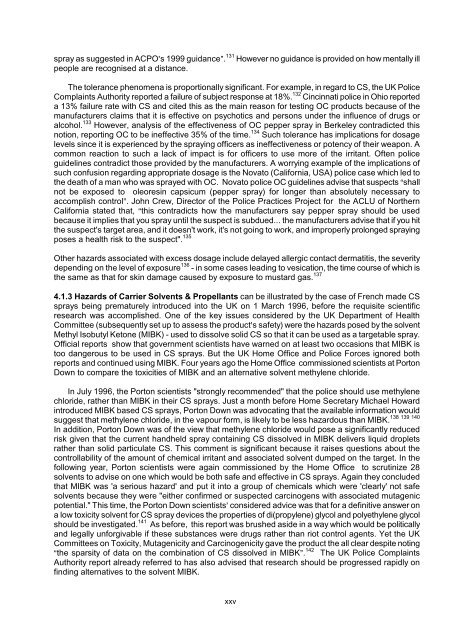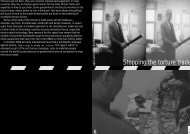CROWD CONTROL TECHNOLOGIES - Omega Research Foundation
CROWD CONTROL TECHNOLOGIES - Omega Research Foundation
CROWD CONTROL TECHNOLOGIES - Omega Research Foundation
You also want an ePaper? Increase the reach of your titles
YUMPU automatically turns print PDFs into web optimized ePapers that Google loves.
spray as suggested in ACPOs 1999 guidance(. 131 However no guidance is provided on how mentally ill<br />
people are recognised at a distance.<br />
The tolerance phenomena is proportionally significant. For example, in regard to CS, the UK Police<br />
Complaints Authority reported a failure of subject response at 18%. 132 Cincinnati police in Ohio reported<br />
a 13% failure rate with CS and cited this as the main reason for testing OC products because of the<br />
manufacturers claims that it is effective on psychotics and persons under the influence of drugs or<br />
alcohol. 133 However, analysis of the effectiveness of OC pepper spray in Berkeley contradicted this<br />
notion, reporting OC to be ineffective 35% of the time. 134 Such tolerance has implications for dosage<br />
levels since it is experienced by the spraying officers as ineffectiveness or potency of their weapon. A<br />
common reaction to such a lack of impact is for officers to use more of the irritant. Often police<br />
guidelines contradict those provided by the manufacturers. A worrying example of the implications of<br />
such confusion regarding appropriate dosage is the Novato (California, USA) police case which led to<br />
the death of a man who was sprayed with OC. Novato police OC guidelines advise that suspects )shall<br />
not be exposed to oleoresin capsicum (pepper spray) for longer than absolutely necessary to<br />
accomplish control(. John Crew, Director of the Police Practices Project for the ACLU of Northern<br />
California stated that, )this contradicts how the manufacturers say pepper spray should be used<br />
because it implies that you spray until the suspect is subdued... the manufacturers advise that if you hit<br />
the suspect's target area, and it doesn't work, it's not going to work, and improperly prolonged spraying<br />
poses a health risk to the suspect". 135<br />
Other hazards associated with excess dosage include delayed allergic contact dermatitis, the severity<br />
depending on the level of exposure 136 - in some cases leading to vesication, the time course of which is<br />
the same as that for skin damage caused by exposure to mustard gas. 137<br />
4.1.3 Hazards of Carrier Solvents & Propellants can be illustrated by the case of French made CS<br />
sprays being prematurely introduced into the UK on 1 March 1996, before the requisite scientific<br />
research was accomplished. One of the key issues considered by the UK Department of Health<br />
Committee (subsequently set up to assess the products safety) were the hazards posed by the solvent<br />
Methyl Isobutyl Ketone (MIBK) - used to dissolve solid CS so that it can be used as a targetable spray.<br />
Official reports show that government scientists have warned on at least two occasions that MIBK is<br />
too dangerous to be used in CS sprays. But the UK Home Office and Police Forces ignored both<br />
reports and continued using MIBK. Four years ago the Home Office commissioned scientists at Porton<br />
Down to compare the toxicities of MIBK and an alternative solvent methylene chloride.<br />
In July 1996, the Porton scientists "strongly recommended" that the police should use methylene<br />
chloride, rather than MIBK in their CS sprays. Just a month before Home Secretary Michael Howard<br />
introduced MIBK based CS sprays, Porton Down was advocating that the available information would<br />
suggest that methylene chloride, in the vapour form, is likely to be less hazardous than MIBK.<br />
xxv<br />
138 139 140<br />
In addition, Porton Down was of the view that methylene chloride would pose a significantly reduced<br />
risk given that the current handheld spray containing CS dissolved in MIBK delivers liquid droplets<br />
rather than solid particulate CS. This comment is significant because it raises questions about the<br />
controllability of the amount of chemical irritant and associated solvent dumped on the target. In the<br />
following year, Porton scientists were again commissioned by the Home Office to scrutinize 28<br />
solvents to advise on one which would be both safe and effective in CS sprays. Again they concluded<br />
that MIBK was 'a serious hazard' and put it into a group of chemicals which were 'clearly' not safe<br />
solvents because they were "either confirmed or suspected carcinogens with associated mutagenic<br />
potential." This time, the Porton Down scientists considered advice was that for a definitive answer on<br />
a low toxicity solvent for CS spray devices the properties of di(propylene) glycol and polyethylene glycol<br />
should be investigated. 141 As before, this report was brushed aside in a way which would be politically<br />
and legally unforgivable if these substances were drugs rather than riot control agents. Yet the UK<br />
Committees on Toxicity, Mutagenicity and Carcinogenicity gave the product the all clear despite noting<br />
)the sparsity of data on the combination of CS dissolved in MIBK(. 142 The UK Police Complaints<br />
Authority report already referred to has also advised that research should be progressed rapidly on<br />
finding alternatives to the solvent MIBK.




